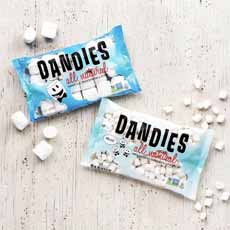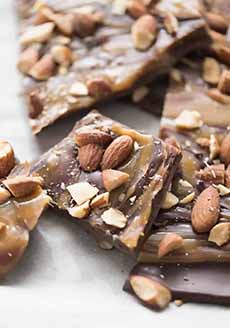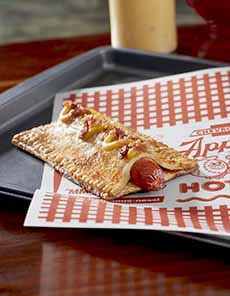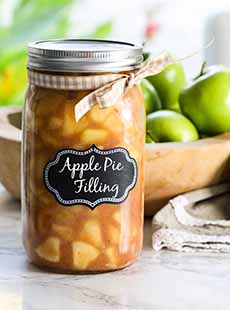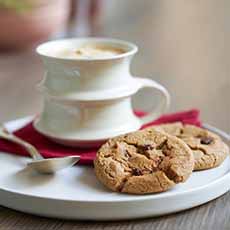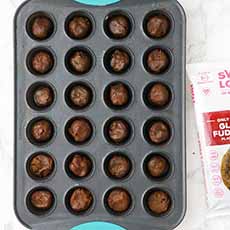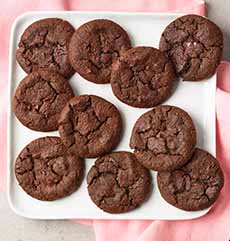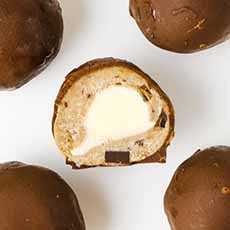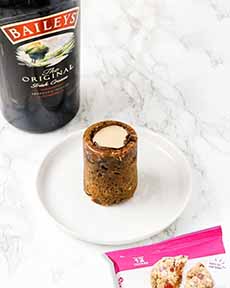|

[1] The Emporium Selection Summer Alcohol Cheese Collection trio from Aldi. There’s more about it below (photo © Aldi).

[2] Wenslydale lends itself to blending with fruit. Here, a mango-flavored variety (not part of the Aldi collection—photo © iGourmet).

[3] For a sublime Wensleydale experience, it doesn’t get better than Old Roan Wensleydale (photos #3, #4 and #5 © The Home Farmer).

[4] Milk is curdled into curds. If the cheese is being blended, it is at this point that the fruit is mixed in. Either way, the curds are then formed into rounds and placed in a maturing room (a.k.a. aging room, cave or cellar).

[5] The maturing room. Note the different ages of the cheeses: the white rounds newly formed, and two older versions with rinds.
|
|
We love good cheese, and eat it just about every day. We’re not talking about the mozzarella on pizza or the cheddar slices on cheeseburgers, although we eat those, too.
We’re talking about cheeses that delight, from favorite dairies like Cypress Grove, Jasper Hill Farm, Rogue Creamery, Uplands Cheese Company and Vermont Creamery.
For us, these are “serious cheeses.” But we also like what we think of as “fun cheeses.”
These are excellent cheeses that are also fun to eat: Burrata, with its oozing, creamy center; Gorgonzola Dolce, creamy, mild, and sweet per its name (dolce means sweet in Italian); Halloumi, a semisoft Greek cheese that becomes a grilled slab of cheese without melting; and Raclette, a cheese that is heated until melty and then scraped onto potatoes, vegetables and meats.
THREE BLENDED WENSLEYDALES FROM ALDI
Here’s more fun cheese from Aldi.
Imported from the U.K. and exclusive to Aldi, The Emporium Selection Summer Alcohol Cheese Collection comprises three English Wensleydale cheeses, blended with the flavors of three popular cocktails.
A medium-bodied cheese that is supple and crumbly, plain Wensleydale has a slight honey aroma. It’s commonly flavored with apples, dried cranberries, mango, pineapple and other fruits. These are called blended cheeses, and are charming.
At Aldi, they’re available beginning August 25th. Wenslydale cheeses are blended with fruit†*:
Espresso Martini: Wensleydale is blended with chopped chocolate-coated coffee beans and an all-natural Espresso Martini flavoring. The result is a dynamite snack or dessert cheese with a sweet coffee/chocolate flavor and aroma. Try it with your iced coffee.
Peach Bellini: Wensleydale is blended diced peaches, peach jam, and the flavor of Prosecco to create a cheese with a fragrant, sweet and fruity aroma and a mouthful of peachiness. Enjoy it with white wine or a spritz.
Piña Colada: Wensleydale cheese is blended with diced pineapple and peaches and, although it isn’t listed on the label, we detect coconut, too—not just coconut flavoring. A great interpretation of the Piña Colada in cheese form.
The six-ounce cheese squares do not contain alcohol†, but are skillfully flavored to give the impression of the cocktail. They are made with rBST-free milk.
All three are a real treat, for breakfast, lunch or dinner.
They’re perfect with summery wines and cocktails, delicious as a snack, and luscious as dessert cheese.
We were treated to samples, and couldn’t stop eating them. We’re headed to the nearest Aldi for more.
ABOUT WENSLEYDALE CHEESE
A popular cow’s milk cheese originally produced in Wensleydale, North Yorkshire, England, today Wenslydale is mostly made in large commercial creameries throughout the U.K.‡
Wensleydale cheese was first made by French Cistercian monks, who traveled from the Roquefort region of France to build a monastery in Wensleydale, England. They brought a recipe for making cheese from sheep’s milk, which is the major cheese milk in the Roquefort region.
During the 14th century, cows’ milk began to be used, and the character of the cheese began to change. A small amount of sheep’s milk was still mixed in to provide a better texture, and to allow the development of blue mold.
At that time, Wensleydale was almost always a blue cheese (like Roquefort); the white variety almost unknown. Today, the opposite is true: It is difficult to find a blue Wensleydale.
When the monastery closed in 1540, local farmers continued to make the cheese.
The first creamery to produce Wensleydale commercially was established in 1897 in the town of Hawes, a market town in North Yorkshire.
With the onset of World War II, most milk in the country was used for making “Government Cheddar,” the rationed cheese. Even after rationing ceased in 1954, cheese making did not return to pre-war levels.
Wensleydale Dairy Products, which purchased the Wensleydale Creamery in 1992, sought to protect the name “Yorkshire Wensleydale” under an EU regulation. PGI status‡‡ was awarded in 2013 [source].
To taste it in its purest form today, look for “Yorkshire Wensleydale,” a PGI cheese whose name can only be used for cheeses that are made in Wensleydale (see photo #3).
Plain or blended, Wensleydale is found on many a cheese board, and is a favorite dessert cheese.
In Yorkshire and North East England, it is often served with fruit cake or Christmas cake.
Apple pie with white Wensleydale is popular in Yorkshire.
|
At the opposite end of the country, in the area around the English village of Cheddar in Somerset, South West England, the local Cheddar is served with apple pie.
The combination is a custom that likely dates back to Medieval times. It came to New England with British immigrants, and became “a Yankee thing” (like England, New England was apple country).
The practice spread to the upper Midwest (dairy country) [source].
If you haven’t had it, treat yourself to a slice of apple pie with Cheddar—and another slice with Wensleydale!
> THE DIFFERENT TYPES OF CHEESE
________________
*Food 101: Both the coffee beans and cacao beans (used in the Espresso Martini cheese) are fruits.
†Beyond the casual Port Wine Cheddar spread, where wine is mixed in, numerous sophisticated cheeses are washed (“bathed”) with some type of alcohol as it ages in the maturing room. The nuances penetrate the paste (the inside of the cheese), creating complex flavors. Examples include Aged Cheddar with Irish Whiskey, AleHouse Cheddar Cheese, Drunken Goat Cheese (red wine), Epoisses (pomace brandy), Finger Lakes Champagne Cheddar Cheese and Stinking Bishop (pear brandy).
‡It’s the same with Cheddar, Swiss (Emmenthal), and any other cheese that is so popular that grocers nationwide need to be filled with it. Artisan cheeses like the Wensleydale shown in photo #3 comprise a tiny fraction of the volume produced. It’s the same in the U.S. and in other cheese-making countries.
‡‡Protected Geographical Indication (PGI) is a status awarded by the European Commission that protects and promotes named regional food products that have a reputation or noted characteristics specific to that area.
|







